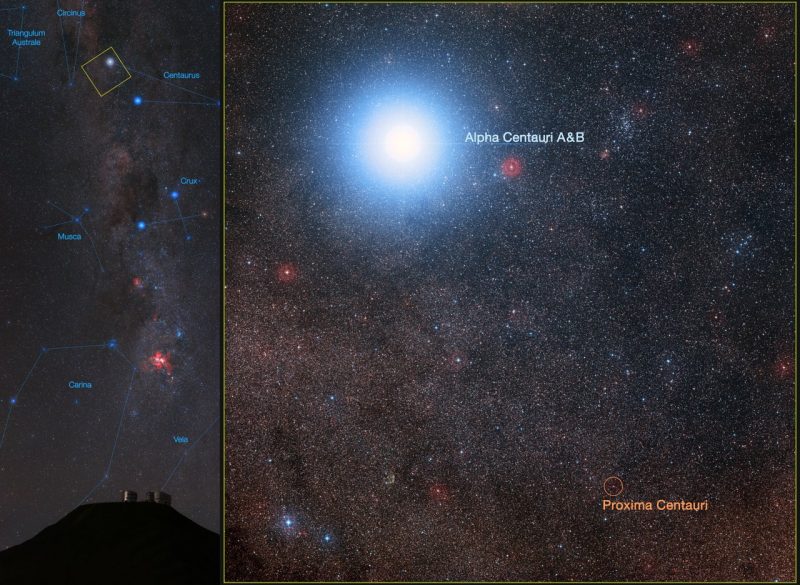
If you ever heard professional astronomers talking among themselves, you wouldn’t hear much talk of light-years. The concept of a light-year – the distance light travels in a single earthly year, or about 6 trillion miles (nearly 10 trillion km) – is a great way to think about distance scales in the universe. But light-years aren’t as useful as parsecs when it comes to measuring those distances. A parsec – a unit of distance equal to about 19 trillion miles (more than 30 trillion km) – is more closely related to how astronomers go about the business of figuring out the size of the universe.
To find the distance to a nearby star, astronomers use triangulation. You can try it for yourself, right now. Hold your finger in front of your face, focus on something in the distance, and close first one eye, then the other eye. As you alternate eyes, you’ll notice your finger appears to dance back and forth in front of your face. The motion is, of course, an illusion. Your finger isn’t moving. Each eye sees your finger from a slightly different angle. So the finger’s location, relative to stuff in the background, looks different. This apparent shift is called parallax, from a Greek word meaning alternation.
If you measure the angle over which your finger appears to move, you can figure out how far your finger is from your face. Likewise, astronomers measure angles to find the distances to stars. Rather than blink their eyes, however, astronomers move the Earth.
Or rather, we use the fact that Earth moves around the sun.
Ready for a definition of parsec? Here it is. One parsec is the distance to an object whose parallax angle is one arcsecond. Don’t be thrown by the terms parallax angle, and arcsecond. Keep reading, and we’ll explain.
The video below from Las Cumbres Observatory does a good job explaining what a parallax angle is.
Or look at the diagram below. It illustrates the definition of parallax angle, and also of the word parsec:

Let’s see how these illustrations actually work, in astronomy. If, for example, we observe a star in December, and then look at it again in June, the Earth will have gone halfway around its orbit. We’re looking at the star from two locations around 186 million miles (300 million km) apart. If the star is reasonably close, then – from one side of Earth’s orbit to the other – it will appear to move ever so slightly.
Add some trigonometry, and the parallax angle, combined with the size of Earth’s orbit, lets astronomers calculate the distance to the star.

These angles are miniscule. They’re too small for degrees to be a practical unit of measurement. That’s why parallax angles are typically measured in arcseconds – a unit of measurement equivalent to the width of an average human hair seen from 65 feet (20 meters) away – not degrees. There are 3,600 arcseconds in one degree.
And here’s how we arrive at parsecs as a unit of distance: one parsec is the distance to an object whose parallax angle is one arcsecond.
The term parsec is just over 100 years old. It first appeared in a 1913 paper by English astronomer Sir Frank Watson Dyson, and the term stuck. If you see a star with 1/2 arcsecond of parallax, it is two parsecs away. At 1/3 arcsecond, it is three parsecs away. And so on.
Basically, astronomers liked it because it made the math easier!

One parsec is approximately 19 trillion miles (30 trillion km). That’s a bit over three light-years. The Voyager 1 probe, launched in 1977, is the most distant manmade object from Earth. It is a mere six ten-thousandths of a parsec away. The nearest star to the sun, a small red dwarf named Proxima Centauri, is just over one parsec from us.
That is actually fairly typical in our neck of the galaxy – one star for every cubic parsec – but it’s not typical everywhere. In the cores of globular clusters, the density can reach well over a hundred stars per cubic parsec!
The center of the galaxy lies just over 8,000 parsecs from us in the direction of the constellation Sagittarius.
The Andromeda Galaxy, the closest spiral galaxy to our own, is nearly 800 kiloparsecs away. A kiloparsec is one thousand parsecs.
At larger scales, astronomers start to talk of megaparsecs and even gigaparsecs. That’s one million and one billion parsecs, respectively. These are generally reserved for the largest structures in existence. The Virgo Cluster, a conglomeration of thousands of galaxies towards which our own Local Group is falling, lies 16 megaparsecs from home. It would take 54 million years to reach it traveling at the speed of light.

Bottom line: One parsec is defined as the distance to a star that shifts by one arcsecond from one side of Earth’s orbit to the other. One parsec is about 30 trillion kilometers, or just over three light-years.











